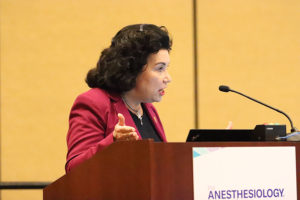Keeping children safe during anesthesia requires evidence-based knowledge of how to prevent, identify and manage anesthesia-related complications. It’s an issue that develops more often in children than adults.
In Saturday’s session “Complications in Pediatric Anesthesia — How to Stay Out of Trouble!,” Linda J. Mason, M.D., FASA, Professor of Anesthesiology and Pediatrics, Loma Linda University, and ASA President-Elect, discussed three common complications: emergence agitation, laryngospasm and cardiac arrest.

Linda J. Mason, M.D., FASA, discussed complications in keeping children safe during anesthesia.
Emergence agitation can occur with any anesthetic agent but is commonly associated with inhalational drugs. Several other factors have been identified, with three being found as independent risk factors: otorhinolaryngology procedures (including tonsillectomy), time to awakening and the use of isoflurane. Younger children also are at increased risk.
In considering the prevention and management of emergence agitation, premedication has not been helpful in preventing the complication. By contrast, dexmedetomidine has been useful.
“Dexmedetomidine has made a big difference in addressing emergence agitation,” said Dr. Mason. “It is an excellent addition to your anesthetics.”
A rapid I.V. bolus of dexmedetomidine 0.5 ug/kg can be given either 5 minutes before the end of the procedure as a preventive measure or in the recovery room as treatment. Propofol also may be helpful in treating emergence agitation.
Laryngospasm remains a substantial problem and must be addressed early, she said, especially given its association with cardiac arrest. Five of 1,000 children with laryngospasm will have cardiac arrest.
Dr. Mason noted that common risk factors are young age (less than 2 years old), upper-respiratory tract infection and/or copious secretions and exposure to environmental tobacco smoke. The use of a laryngeal mask airway does not protect against laryngospasm.
She emphasized the importance of early management of laryngospasm by pulling the jaw forward and lifting the chin.
“You must get the airway open,” she said, and recommended 100 percent oxygen with gentle positive pressure.
Also, she advised having succinylcholine on hand but using it only when necessary. If there is no I.V. access, succinylcholine can be given intramuscularly in the deltoid muscle, as the time to onset is quicker.
The causes of anesthesia-related cardiac arrest have changed over time, with medication-related causes decreasing, primarily with the introduction of sevoflurane, while respiratory and cardiovascular causes have increased. Several studies have shown that the majority of children who have cardiac arrest have cardiac disease (congenital or acquired).
“We need to know about these children before we put them to sleep,” said Dr. Mason. “Make sure the child does not have underlying cardiac disease.”
Careful monitoring is vital. Dr. Mason urged anesthesiologists to address early changes in pulse oximetry and capnography readings and also to monitor with a stethoscope.
“Listen to the chest. It’s important to use your eyes and ears to prevent cardiac arrest,” she said. “Epinephrine is the single most useful drug — don’t waste time with repeated atropine doses.”
Dr. Mason said the development of new anesthetic drugs is not the answer to preventing anesthesia-related complications. Instead, it’s important to improve the infrastructure to monitor these events. Additionally, pediatric anesthesiologists and surgeons must function as a team to conduct research and create centralized pediatric registries with meaningful outcomes.
Return to Archive Index